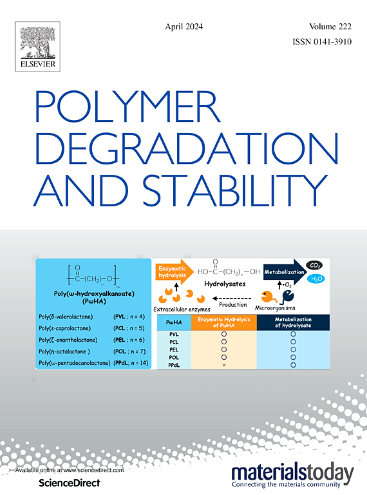受银杏果生物启发的弧形空气层可为 PET 织物抵御高湿环境
IF 6.3
2区 化学
Q1 POLYMER SCIENCE
引用次数: 0
摘要
开发工艺简单、效果显著的聚酯(PET)织物抗湿热老化改性方法是一项艰巨的挑战。本研究受天然银杏果银镜现象的启发,利用多面体低聚硅倍半氧烷(ZnO@POSS)包裹氧化锌(ZnO)的豌豆荚状纳米粒子和聚二甲基硅氧烷(PDMS),在 PET 织物表面构建稳定的弧形空气层,以抵御高湿环境。PET 织物表面豌豆荚状 ZnO@POSS 的圆腹结构和 PDMS 辅助的交错物理网络起到了捕获和保留空气的关键作用,使得弧形空气层的容量明显大于水下的其他微结构。水蒸气被阻止进入织物间隙,从而有效抑制了 PET 高分子链的自催化水解行为,在加速湿热老化试验(60 °C, 80 % RH, 600 h)后,PET 织物的强度保持率从 45 % 显著提高到 89 %。这项工作是提高 PET 织物在高湿度环境中耐用性的一种简单而有效的方法。本文章由计算机程序翻译,如有差异,请以英文原文为准。
Arc-shaped air layer bioinspired by ginkgo nut to resist high humidity environment for PET fabrics
Developing simple processes and significant effect modification method for polyester (PET) fabrics to resist hygrothermal aging is a formidable challenge. In this study, inspired by the silver mirror phenomenon of natural ginkgo nut, we utilized the pea pod-shaped nanoparticles that zinc oxide (ZnO) was encapsulated in polyhedral oligomeric silsesquioxane (ZnO@POSS), and polydimethylsiloxane (PDMS) to construct stabilized arc-shaped air layer on the PET fabric surface to resist high humidity environment. The round belly structures of pea pod-shaped ZnO@POSS and interlaced physical networks assisted by PDMS on the PET fabrics surface served as the crucial roles to capture and retain air, resulting in the capacity of the arc-shaped air layer was significantly larger than other microstructures underwater. The water vapor was prevented from entering the fabric interstices that the self-catalytic hydrolysis behavior of PET macromolecular chains was efficiently restrained, and the strength retention of PET fabric was significantly improved from 45 % to 89 % after accelerated hygrothermal aging test (60 °C, 80 % RH, 600 h). This work represents a simple and effective approach to improve the durability for PET fabrics in high humidity environments.
求助全文
通过发布文献求助,成功后即可免费获取论文全文。
去求助
来源期刊

Polymer Degradation and Stability
化学-高分子科学
CiteScore
10.10
自引率
10.20%
发文量
325
审稿时长
23 days
期刊介绍:
Polymer Degradation and Stability deals with the degradation reactions and their control which are a major preoccupation of practitioners of the many and diverse aspects of modern polymer technology.
Deteriorative reactions occur during processing, when polymers are subjected to heat, oxygen and mechanical stress, and during the useful life of the materials when oxygen and sunlight are the most important degradative agencies. In more specialised applications, degradation may be induced by high energy radiation, ozone, atmospheric pollutants, mechanical stress, biological action, hydrolysis and many other influences. The mechanisms of these reactions and stabilisation processes must be understood if the technology and application of polymers are to continue to advance. The reporting of investigations of this kind is therefore a major function of this journal.
However there are also new developments in polymer technology in which degradation processes find positive applications. For example, photodegradable plastics are now available, the recycling of polymeric products will become increasingly important, degradation and combustion studies are involved in the definition of the fire hazards which are associated with polymeric materials and the microelectronics industry is vitally dependent upon polymer degradation in the manufacture of its circuitry. Polymer properties may also be improved by processes like curing and grafting, the chemistry of which can be closely related to that which causes physical deterioration in other circumstances.
 求助内容:
求助内容: 应助结果提醒方式:
应助结果提醒方式:


